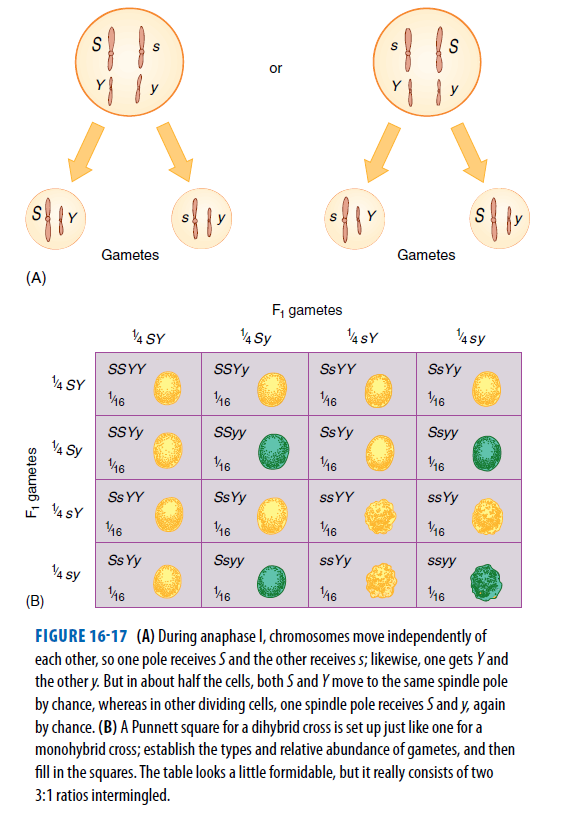S S S or y Gametes Gametes (A) F, gametes 4 sY 4 sy V4 SY 4 Sy SSYY SsYy SSYY SSYY 4 SY 46 46 V46 46 SSyy SsYy Ssyy SSYY V4 Sy 46 16 16 46 SSYY ssYy Ss YY SsYy V4 SY 46 46 46 46 Ss Yy Ssyy ssYy ssyy VA sy 46 46 (B) FIGURE 16-17 (A) During anaphase I, chromosomes move independently of each other, so one pole receives S and the other receives s; likewise, one gets Y and the other y. But in about half the cells, both S and Y move to the same spindle pole by chance, whereas in other dividing cells, one spindle pole receives S and y, again by chance. (B) A Punnett square for a dihybrid cross is set up just like one for a monohybrid cross; establish the types and relative abundance of gametes, and then fill in the squares. The table looks a little formidable, but it really consists of two 3:1 ratios intermingled. F, gametes
S S S or y Gametes Gametes (A) F, gametes 4 sY 4 sy V4 SY 4 Sy SSYY SsYy SSYY SSYY 4 SY 46 46 V46 46 SSyy SsYy Ssyy SSYY V4 Sy 46 16 16 46 SSYY ssYy Ss YY SsYy V4 SY 46 46 46 46 Ss Yy Ssyy ssYy ssyy VA sy 46 46 (B) FIGURE 16-17 (A) During anaphase I, chromosomes move independently of each other, so one pole receives S and the other receives s; likewise, one gets Y and the other y. But in about half the cells, both S and Y move to the same spindle pole by chance, whereas in other dividing cells, one spindle pole receives S and y, again by chance. (B) A Punnett square for a dihybrid cross is set up just like one for a monohybrid cross; establish the types and relative abundance of gametes, and then fill in the squares. The table looks a little formidable, but it really consists of two 3:1 ratios intermingled. F, gametes
Biology: The Unity and Diversity of Life (MindTap Course List)
15th Edition
ISBN:9781337408332
Author:Cecie Starr, Ralph Taggart, Christine Evers, Lisa Starr
Publisher:Cecie Starr, Ralph Taggart, Christine Evers, Lisa Starr
Chapter14: Chromosomes And Human Inheritance
Section: Chapter Questions
Problem 5GP: Human females have two X chromosomes (XX); males have one X and one Y chromosome (XY). a. With...
Related questions
Topic Video
Question
We say that genes that are close together on the same chromosome are linked. What does that mean? Imagine that in a diploid nucleus, one chromosome has the allele R and right next to it on the same chromosome is the allele T for a different gene. Are these linked? Imagine that r is right next to t on the homologous chromosome. If this cell never undergoes meiosis, does this matter at all? If it does undergo meiosis, what are the two genotypes that the gametes are most likely to have? Look at Figure for help if you need it.

Transcribed Image Text:S
S
S
or
y
Gametes
Gametes
(A)
F, gametes
4 sY
4 sy
V4 SY
4 Sy
SSYY
SsYy
SSYY
SSYY
4 SY
46
46
V46
46
SSyy
SsYy
Ssyy
SSYY
V4 Sy
46
16
16
46
SSYY
ssYy
Ss YY
SsYy
V4 SY
46
46
46
46
Ss Yy
Ssyy
ssYy
ssyy
VA sy
46
46
(B)
FIGURE 16-17 (A) During anaphase I, chromosomes move independently of
each other, so one pole receives S and the other receives s; likewise, one gets Y and
the other y. But in about half the cells, both S and Y move to the same spindle pole
by chance, whereas in other dividing cells, one spindle pole receives S and y, again
by chance. (B) A Punnett square for a dihybrid cross is set up just like one for a
monohybrid cross; establish the types and relative abundance of gametes, and then
fill in the squares. The table looks a little formidable, but it really consists of two
3:1 ratios intermingled.
F, gametes
Expert Solution
This question has been solved!
Explore an expertly crafted, step-by-step solution for a thorough understanding of key concepts.
Step by step
Solved in 3 steps

Knowledge Booster
Learn more about
Need a deep-dive on the concept behind this application? Look no further. Learn more about this topic, biology and related others by exploring similar questions and additional content below.Recommended textbooks for you

Biology: The Unity and Diversity of Life (MindTap…
Biology
ISBN:
9781337408332
Author:
Cecie Starr, Ralph Taggart, Christine Evers, Lisa Starr
Publisher:
Cengage Learning

Concepts of Biology
Biology
ISBN:
9781938168116
Author:
Samantha Fowler, Rebecca Roush, James Wise
Publisher:
OpenStax College

Biology: The Unity and Diversity of Life (MindTap…
Biology
ISBN:
9781337408332
Author:
Cecie Starr, Ralph Taggart, Christine Evers, Lisa Starr
Publisher:
Cengage Learning

Concepts of Biology
Biology
ISBN:
9781938168116
Author:
Samantha Fowler, Rebecca Roush, James Wise
Publisher:
OpenStax College